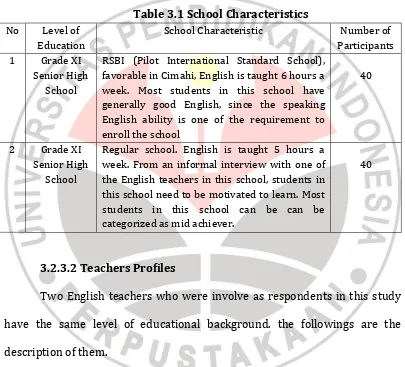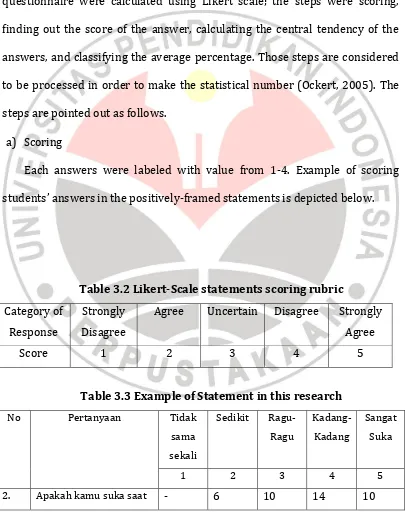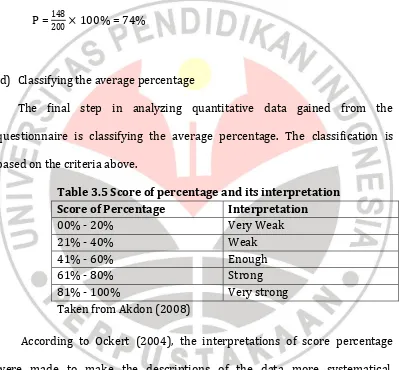Nadya Nitiswari, 2012
CHAPTER III
RESEARCH METHODOLOGY
This chapter will discuss the methodology that the researcher has
applied in this study. There are five sections that are going to be elaborated
in this chapter. The first section is the research question, the second section
is the design which presents the method used in conducting the research and
how the study is carried out. The research site and the elaboration on the
participants involved in the study will be elaborated in the third section. The
data collection and the instrument applied in the study will be discussed in
section fourth. The last section that is the fourth section will give an overview
of how the data in this study is collected, analyzed, and interpreted.
3.1 Research Question
As mentioned in Chapter One, this study aims to, firstly, investigate
realizations of the use of L1 in the EFL classroom. Secondly, this study aims to
find out the teachers and students perspectives of the use of L1 in the EFL
classroom. Thus to meet these two purposes, two research questions are
proposed:
2. What are the perspectives of the Teachers and Students about the
use of L1 in the EFL Classroom?
3.2Methodology
3.2.1 Research Design
The type of the research is falls under the category of case study which is
qualitative in nature. Paton (2001) as quoted in Golafshani (2003) states that
qualitative research uses a naturalistic approach that seek to understand
phenomena in context-specific setting such as real world setting where
researcher does not attempt to manipulate the phenomenon of interest. The
research also will utilize a survey approach that will be collected through
questionnaire. Therefore, the focus is on describing the realization of L1 used
in the EFL classroom, the teachers’ perspectives and the reason of using L1 in
the EFL classroom and also the students’ attitudes toward it.
3.2.2 Research Site
The research was undertaken at two Public Senior High School in
Cimahi-Jawa Barat. The first school is a regular school and the second school is RSBI
School. The school was chosen for the present study due to several reasons.
The first reason for choosing the school was because the researcher was the
alumni of school 1 so it gave relatively easy access to do the research.
Moreover, the second school was chosen because the researcher was familiar
Nadya Nitiswari, 2012
Another reason for choosing this school was both of the school was the
familiarity of the teacher and the students. The teacher had taught the
students for one semester, so she had been familiar with the students.
Therefore, it was expected that there will be natural performance in the
instructional process during this study (Emilia, 2005).
3.2.3 Participants
The participants of the study were two English teacher and the two
classes of the eleventh grader consisting of 40 students each classroom.
Grade eleven were chosen in this research, the reason for choosing eleventh
grade is because they are not focusing themselves on the National
Examination (UN), so the research hopefully will not disturb the preparation
of the examination. The purpose of choosing one whole class is also based on
the researcher’s intention to have a real picture of a classroom situation
mainly in terms of number which, in Indonesian context, mostly of large class
consisting 35- students. This choice is in line with Van Lier’s suggestion to
have research in ongoing and regular classes (1988) that further contribute
to the reliability of the study.
3.2.3.1 School Profiles
School characteristics can be seen in the table 3.1 below. Information
on school and student characteristic were obtain from classroom
classroom and from informal interviews with some English teachers at these
RSBI (Pilot International Standard School), favorable in Cimahi, English is taught 6 hours a week. Most students in this school have generally good English, since the speaking English ability is one of the requirement to this school need to be motivated to learn. Most students in this school can be can be
Teacher A was graduated from English Education Department of a private
university in Bandung. She has been teaching English at School 1 since 1984
up to present. To develop her knowledge in teaching English, she will enroll
Nadya Nitiswari, 2012
Teacher B was graduated from English Education Department of a state
university in Bandung. She has been teaching English for 20 years, but it was
her 15 year-teaching in school 2. She has participated some workshops and
seminars to improve her knowledge in teaching English.
3.3Data Collection Method
This part elaborates how the data obtained in the study. The descriptions
are presented below:
3.3.1 Preliminary Study
Two pilot studies were conducted prior to the real study. Both of pilot
study was conducted in a second grade of senior high school in Cilegon. In
these schools, the data needed in this study were significantly found during
learning activities.
3.3.2 Classroom Observation and Classroom Video-recording
Classroom observation was the first data collection techniques used in
this study. A video recorder was used to collect a natural data and as clear as
possible. According to Van Lier (1988), recording was not only functions as a
means for description and analysis in a research, but also as an estrangement
observations and recordings were conducted six times for each class from Jan
12th until Feb 13th 2011.
The field notes were also utilized to support the data gathered from
audio recordings during the observation. The notes were used to assist in
coding the data and to provide the researcher with information, which are
not included in video recorder. In addition, the transcriptions of the
classroom observation in this study are provided in Appendix A.
3.3.3 Teachers Interview
The second data collection techniques used in this study were an
interview with all participating teachers in this study. The interview data in
this study were used to obtain the teachers perspectivess of the use of L1 in
the EFL classroom. This enabled the researcher to verify the teachers’ use of
L1 in the classroom.
In this study, two English teachers from two different public schools in
Cimahi were interviewed to obtain information about their perspectives in
the use of Bahasa Indonesia in EFL classroom. Those teachers were selected
purposively. In addition, this interview was conducted after the process of
the video recording had been completed to obtain more comprehensive data
on their perspectives regarding with the use of L1 in EFL classroom.
The question items of the interviews were originally designed by
Nadya Nitiswari, 2012
researcher to obtain more detailed information about a person’s thoughts.
The interview questions cover the teacher background information, their
opinions on a number of statements about the use of the L1 in the EFL
classroom, and the final part focused on the teachers’ use of L in the
classroom. In addition, the interview questions which were used in this
study and the transcriptions of the interview is provided in Appendix B.
3.3.4 Students Questionnaire
Students’ questionnaire was the last data collection techniques used in
this study. A questionnaire is relevant with this study in order to find out the
participants attitudes, as supported by Fasold (1984) who mentions that
methods for determining language attitudes can be either direct or indirect.
Direct method requires subjects to respond to a questionnaire or interview
questions that simply ask their opinion about one or another language.
The questionnaire consists 6 items and uses Bahasa Indonesia to avoid
students’ misinterpretation. The questionnaire was inspired by Schweers’s
research in 1999 and Emilia’s research in and then developed by the
researcher to meet the research needs. In this study, the researcher
administered both the opened-ended and the close-ended questionnaires.
Two from six questions were in the form of Likert scale questionnaire.
The questions was designed as a structured questionnaire since it aimed at
obtaining specific data which were needed to analyze the students
addition, the questionnaire which was used in this study is provided in
Appendix C.
3.4Data Analysis
3.4.1 Data from Classroom observation
Data from observation were used to get factual phenomenon of the
teachers’ activities in the classroom dealing with the use of L1 in the EFL
classroom. The data from observation result were analyzed based on the
amount of the used bahasa Indonesia and the discourse context in EFL
classroom. The researcher presents in the class as non-participant observer
and the researcher will describe the phenomenon that she investigated
descriptively and factually.
The amount of Bahasa Indonesia (L1) spoken by teachers and students
were analyzed by adopting the method of quantifying proposed by Duff and
Polio (1990). This method used an utterance as a basic unit. With reference
to this method, each coded utterances produced by teacher were then
categorized into TL refers to utterances completely in L or with one word
or phrase in Bahasa Indonesia; and Mixed refers to utterances completely
in Bahasa Indonesia or with one word or phrase in L2, plus utterances with
an equal mixture of Bahasa Indonesia and English.
Nadya Nitiswari, 2012
The data from Interview aimed to answer the second research question;
the perspectives of teachers and students in using Bahasa Indonesia in EFL
classroom. The data from interview were firstly transcribed. During the
transcription stage, teacher’s names were replaced with alias names (Kvale,
1996). Secondly, the data that have been transcribed were categorized based
on the themes which were related to the research questions. Thirdly, the data
from the interview were subsequently presented in condensed body of
information. To keep the objectivity of the study in analyzing the data, during
the transcribing process the participants name were changed into alias name
(Kvale, 1996). In the final step, to follow Cohen and Manion, (1994) and Kvale
(1996) the transcripts were given back to the participants to make sure that
it was exactly what the teachers said and meant.
3.4.3 Data from Questionnaire
The data from questionnaire aimed to answer research question
number two; the students’ perspectives on the use of bahasa Indonesia in the
classroom and the benefit of using bahasa Indonesia in the EFL classroom.
The questionnaire consisted of 6 questions, 2 of the question were in the
form of likert-scale, and 4 questions were in the form of open-ended
questions. (the questionnaire can be seen in appendix C)
The data were analyzed qualitatively using thematic analysis. The data
interpreted based on the category. The following are the calculation of the
Likert-scale.
3.4.3.1 Calculating the Likert Scale
To follow Ockert (2005), two answers (see appendix C) gained from the
questionnaire were calculated using Likert scale; the steps were scoring,
finding out the score of the answer, calculating the central tendency of the
answers, and classifying the average percentage. Those steps are considered
to be processed in order to make the statistical number (Ockert, 2005). The
steps are pointed out as follows.
a) Scoring
Each answers were labeled with value from 1-4. Example of scoring
students’ answers in the positively-framed statements is depicted below.
Table 3.2 Likert-Scale statements scoring rubric
Category of
Response
Strongly
Disagree
Agree Uncertain Disagree Strongly
Agree
Score 1 2 3 4 5
Table 3.3 Example of Statement in this research
Nadya Nitiswari, 2012
gurumu menggunakan
Bahasa Indonesia di
kelas Bahasa Inggris?
b) Finding out the score of the answer
To find out the score of each answer (table 3.3), the frequencies of the
students answer are multiplied with the value of each answer.
score for option A (strongly disagree) : 0 x 1 = 0
score for option B (disagree) : 6 x 2 = 12
score for option C (neutral) : 10 x 3 = 30
score for option D (agree) : 14 x 4 = 56
score for option E (strongly agree) : 10 x 5 = 50 +
Total 148
notes:
- the ideal score for the lowest value = 1 x 40 (students) = 40
- the ideal score for the highest value = 5 x 40 (students) = 200
c) Calculating the central tendency of the respondents
Calculating the central tendency of the respondents employs the formula
as shown as:
P=
�× 100%
P : Percentage
fo : The total value of answer
n : The ideal score of the highest value (Taken from Sudjana, 1984)
The calculation of the central tendency of the respondents as follow:
P = 148200× 100% = 74%
d) Classifying the average percentage
The final step in analyzing quantitative data gained from the
questionnaire is classifying the average percentage. The classification is
based on the criteria above.
Table 3.5 Score of percentage and its interpretation
Score of Percentage Interpretation
00% - 20% Very Weak
21% - 40% Weak
41% - 60% Enough
61% - 80% Strong
81% - 100% Very strong
Taken from Akdon (2008)
According to Ockert (2004), the interpretations of score percentage
were made to make the descriptions of the data more systematical.
Moreover, the interpretation which based on score percentage was
formulated in order to classify the tendency of the response.
Nadya Nitiswari, 2012
To promote credibility, there are some techniques commonly used in a
qualitative, i.e. triangulation, member check, long-term observation, peer
examination, participatory or collaborative modes of research, and
researcher’s biases, thick description, typically or modal category, and
multisite designs (Merriam, 1998; Cresswell, 1998; see also Alwasilah, 2000)
To establish trustworthiness, the researcher implemented two techniques
namely triangulation and member check. Describing the data as clear as
possible was also done to check the validity of the data. The techniques of
triangulation and member checking are described as follows:
3.5.1 Triangulation
Triangulation refers to the use of various methods in collecting data
needed for the research (Alwasilah, 2002). By applying triangulation, the
researcher takes some benefit. First, the risk of making research conclusion
that is limited to certain method and data source will be reduced. Second, the
validity of the research conclusion will be increased. Therefore, the
researcher triangulated the data by collecting information from three data
resources (i.e. observation, interview, and questionnaire) and from two
different parties (i.e. teachers and students).
3.5.2 Member Check
Member check will be carried out to verify data taken from the interview
transcripts. According to Alwasilah (2002), the advantages of applying
member check are: to avoid researcher’s misinterpretation toward
respondents’ answer in the interview and respondents behavior in
observation, to confirm respondents’ perspective toward ongoing process.
Therefore, member checking was done by asking respondent who had been
interviewed to check the transcripts of the interview.
3.6Summary of Chapter 3
This chapter has discussed the detail context of the study. The
discussion has covered research questions that cover two questions: What
are the realizations of the L1 use in EFL classroom? and What is the students
and teachers perspective on the use of L1 in the EFL classroom? It also covers
the description of a case study as the design used in this study. The setting of
the study were at regular school and RSBI school in Cimahi and it involved
two teacher of 11th grade in two different school as participants. The data for
the study were collected through classroom observation, questionnaire and
interview. A triangulation was applied in order to obtain consistency of the


